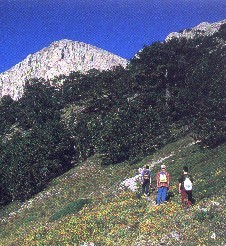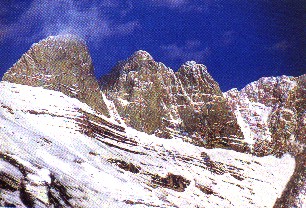|
OLYMPUS
– THE MOUNTAIN OF THE GODS
 Mt Olympus
is probably the only mountain which has managed to keep its my thical
history since the ancient times.
Mt Olympus
is probably the only mountain which has managed to keep its my thical
history since the ancient times.
When
you just face the mountain but mainly when you climb up Olympus you have
the feeling that the gods have never left their palaces and that you will
meet the Muses somewere
The
area around Olympus has been inhabited since the ancient times. The
mountain played an important role in the ancient Greek lives; this can be
seen from the fact that it was the centre of the Greek religious
consciousness and was considered to be the residence of the 12 Olympian
gods, the Muses and many other gods and godesses. The ruins of the ancient
cities Livithra, Pythio and Dion testify this.
In
the Byrantine Era, Olympus was probably ignosed because it was believed to
be the centre of paganism. However during the 400 years when Greece was
under the yoke of the Turks the mountain gained its grande ur again. At
that time it was the symbol of freedom and the symbol of the Greek
National Resistense tache the Turks. Greek partisans (called Klephts and
Armatoli) who fought for freedom wsed Olympus as their base of operations
and made dushes at the Turkish conwuerors from this mountain.
Olympus
is situated between the prefectures of Larisa and Pieria. It separates
Thessalia from Macedonia. It’s the highest mountain in Greece and in
height is 2917 m, the peak is called Mitikas. Other peaks are Skolio (2911
m), Stefani (2909 m), Profitis Ilias (2803 m) and others.
It
has been proclaimed to be a National Sanctuary and it is protected by
International treaties. It’s Floru and fauna are uni que. More than 1700
kindes of plants and herbs have been recorded here. 23 of them are found
only on Olympus. Furthermore, it’s the natural habital for 32 species of
mammuls and 105 species of birds.
The
visitor will experience unfogetable moments when he/she climbs up the
mountain. He/she can walk a long lots of paths and admire the wild and
imposing beauty of the mountain.
The
easiest acces to the mountain is from the village called Litohoro. There
is a road which leads to Stavros (945 m altitude) and from there you can
go to Prionia. The longest part of the road is tarred. The visitor takes
pleasure in seening magnificent landscapes on the way to the summit.
At
Stavros and Prionia you can have coffe or something to eat. After walking
for 5 7 hours along the path E4 from Milous at Litohoro you can reach
Prionia. Both the most fastidious climber and a mere walker will be
thrilled by the beauty of the path. On the way he/she meets the historic
monastery Agios Dionisios.

On
Olympus there are ewuipped shelters:
-
Spilios
Agapitos – altitude 2100 m – from May to October, it can af fosd
shelter to 90 persons. It offers accomodation, food, drinks.
-
Christos
Kakalos – altitude 2650 m – It can afford shelter to 18 persons.
-
Giosos
Apostolidis – altitude 2740 m – capucity 80 persons.
From these
shelters you can set out on excursions to Mitikas.
The
climbers and mountaineering club of Litohoro offersgreat help notohly to
climbers but to mere visitors as
The
climbers and Mountaineering club of Litohoro phone number 2352081800
Reference
“Olympus,
the mountain of the god’s” Municipality of Litohoro
Forest
Inspection in Katerini
Newspaper
"Livadi Olympou"
|

